
São Domingos de Rana is a civil parish of the Portuguese municipality of Cascais, part of the Greater Lisbon subregion. The population in 2011 was 57,502, in an area of 20.36 km2. The parish includes the localities Abóboda, Cabeço de Mouro, Caparide, Matarraque, Outeiro de Polima, Polima, Rana, Talaíde, Tires, Trajouce and Zambujal.
Municipium Cives Romanorum Felicitas Julia Olisipo was the ancient name of modern-day Lisbon while it was part of the Roman Empire.
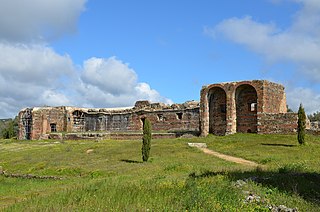
The Roman ruins of São Cucufate is a Romanesque archaeological site, located on the ruins of a Roman-era agricultural farm in the civil parish of Vila de Frades, in the municipality of Vidigueira, in the southern Alentejo, Portugal. The convent, which dates back to Middle Ages, was dedicated to the martyred saint Cucuphas.

The Roman ruins of Villa Cardillio is an archaeological site located in central Portugal. Situated in the rural civil parish of Santa Maria, it is located approximately 3 km from the centre of the municipal seat of Torres Novas. Receiving its name from a mosaic pavement onsite, the specific translation of piece is still unclear, but assumed that the site was owned by a couple. The ruins were first excavated in 1962, yielding hundreds of coins and well as ceramics, bronze works, Assyrian and Egyptian glass works. Also revealed were some jewellery and a statue of Eros.

The Fort of Guincho, also known as the Fort of Velas, is located at the edge of the Praia do Abano, along the southern edge of the coast of the civil parish of Alcabideche, in Cascais Municipality, Lisbon District, Portugal.. It was classified as Property of Public Interest by the national government on 29 September 1977, but today stands in a state of decay, even after studies to remodel the location as a visitors centre for the nearby Sintra-Cascais Nature Park.
Ponte Velha de São Pedro da Torre is a bridge in the civil parish of São Pedro da Torre, municipality of Valença in the Portuguese district of Viana do Castelo.

The Roman Ruins of Cerro da Vila are the remnants of a historical villa in the Algarve region of southern Portugal. Its vestiges lie in the vicinity of the resort and marina of Vilamoura, in the civil parish of Quarteira, municipality of Loulé Municipality.

The Tower of Pedro-Sem is a medieval fortification situated in the civil parish of Lordelo do Ouro e Massarelos, that protected the northern Portuguese city of Porto.
The Roman villa of Vale do Mouro is a Roman settlement situated in the civil parish in the municipality of Meda, excavated since the early 21st century by archaeologists.

The Castle of Alcácer do Sal is a medieval castle located in the civil parish of Alcácer do Sal e Santa Susana, in the municipality of Alcácer do Sal, Portuguese district of Setúbal.
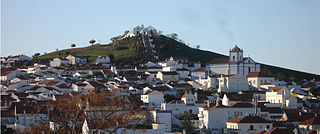
The Castle of Aljustrel is a Portuguese medieval castle in civil parish of Aljustrel e Rio de Moinhos, in the municipality of Aljustrel, in the district of Beja.
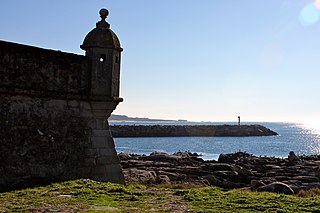
The Fort of Lagarteira is a medieval fort in the civil parish of Vila Praia de Âncora, municipality of Caminha in the Portuguese Norte, classified as a Property of Public Interest.

The Roman Dam of Belas is a 3rd-century Roman barrier constructed to serve the city of Olisipo, located in civil parish of Queluz e Belas, municipality of Sintra.

The Roman ruins of Casais Velhos are the remains of a Roman town, in the municipality of Cascais, Lisbon District, Portugal that included baths, two cemeteries, remains of a wall and ceramic artifacts.
The Roman villa of Outeiro de Polima is a Roman villa in the civil parish of São Domingos de Rana, in the Portuguese municipality of Cascais, dating from the 1st to 6th centuries AD.
The Roman villa of Quinta da Bolacha is a Roman villa in the civil parish of Falagueira-Venda Nova, municipality of Amadora, with an occupation dating from the 3rd and 4th century. It is commonly associated with the nearby Roman aqueduct, as well as the agricultural activities and Chalcedony mining occurring in the district.
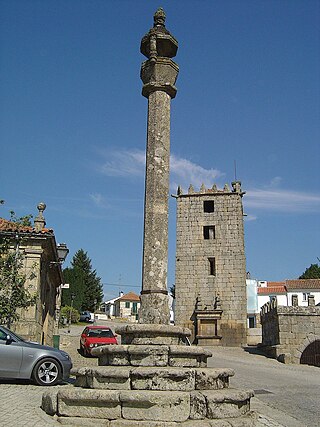
The Pillory of Aguiar da Beira is a pillory located in the civil parish of Aguiar da Beira e Coruche, in the municipality of Aguiar da Beira, Portuguese district of Guarda.

The Roman villa of Freiria is a Roman villa in the civil parish of São Domingos de Rana, in the Portuguese municipality of Cascais.
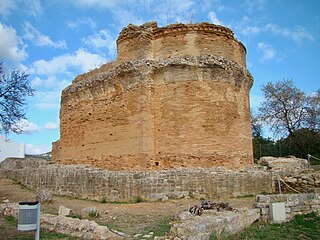
The Roman ruins of Milreu are the remains of an important Roman villa rustica located in the civil parish of Estói in the municipality of Faro, Portugal, classified as a Monumento Nacional. The Milreu ruins constitute the most prominent and well preserved evidence of Roman presence in the Algarve. They are mainly composed of the remnants of a once luxurious villa with annexed thermae and several surrounding buildings, including a temple, mausoleum and industrial and commercial structures. The archaeological site still preserves part of the once exuberant mosaics that decorated the floor and walls of the villa. A 16th century house is also located in the area, alongside an interpretation centre.

Jeannette Nolen was a Dutch archaeologist who carried out extensive research in Portugal.















